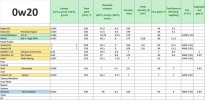Vali_lj
Ek9 dreamer
- Joined
- Apr 24, 2010
- Messages
- 84
This is my first post here so it should be interesting ).gif)
I've done a lot of research to find the best oil to suit my engine (B16A2) the climate , polution , oil rate change ; i live in bucharest romania , the climate is verry severe if i my say so , the temperature drops and get high verry often so the oil is verry diffcult to choose . The other part of the equation of choosing the oil is the level of pollution where the engine is most exploited . So after a couple weeks i've come up with this charts , they are split between grade , brand etc. :
i'm using now Eneos 5w40 (US) , Before Castrol magnatec 5w40 (EU) next Royal Purple or Valvoline (us)
Blue (Pao) Purple( bio_ester) Green ( ester ) , orange ( sintetic ) , Red ( sintetic-blend)
Brand's : Eneos (us si uk) , Fuchs/Silkolene , Motul , Royal Purple ,Amsoil (us si uk) , Mobile 1 (us) , Valvoline (us) , Shell , Esso , Selenia , Gulf , Aral , Castrol (us) , Texaco/Havoline , Liqui Moly , Repsol , Sunoco , Ravenol (EU) , Total , Elf.
Note:
Flash Point :
The flash point is the lowest temperature at which it can vaporize to form an ignitable mixture in air
Kinematic Viscosity
Kinematic viscosity is the measure of an oilâs resistance to flow and shear under the forces of gravity.
Oil has a unique molecular structure, and larger molecules create greater resistance (higher kinematic
viscosity). Highly viscous liquid flows less readily under the force of gravity.
Value:
max @100ºC 9.3 (w20) , 12.5 (w30) , 16.3 (w40)
min @100ºC 5.6 (w20) , 9.3 (w30) , 12.5 (w40)
High Temperature High ShearDViscosity cPs @ 150°C (HTHS)
It determinate lubricants viscosity under severe temperature and shear conditions in the combustion chamber. To prevent premature wear of the lubricant is important to maintain their protective viscosity in conditions of severe operation.In generally manufacturers do not really like this to be made public but we can find value in standard ACEA aporx. :
So if that oil is A3/B3, A3/B4 and C3 then HTHS is greater than 3.5.
For A1/B1 A5/B5 HTHS is less than 3.5.
Attention is about standard ACEA-2004, NOT 98, 97 or another old!
Min value: 2.6 (w20), 2.9 (W30), 2.9 (W40) (only for group 0w40, 5w40, 10W40), 2.7 (W40) (for group 15W40, 20w40, 25w40)
Pour Point
Pour point is the lowest temperature at which lubricant maintains the pour property
Max val -40 ° C
Total Base Number (TBN)
The measure of lubricant reserve of alkalinity which controls acids formed when burning.
The higher value the more effective is in combating the corrosive effects of wear and engine for a longer period of time
Min Val. 6.0
Cold cranking viscosity (CCS)
Indicate the dynamic viscosity of lubricant at low temperatures and its shear. Under these conditions is directly related to lubricant viscosity and engine starting rotation.
As the value is even smaller engine will start (spin) more easily at low temperatures.
Max val. 6600 @ -30 ° C (5W) 6200 @ -35 ° C (0W) 7000 @ -25 ° C (10w)
Sulfated Ash
Indicate the concentration of known metals in oil additives. When phosphorus is absent, boron, calcium, magnesium, sodium and potassium and zinc sulfates are converted into the oxides.
The amount of ash remaining after burning petroleum products or ingredients are inorganic impurities it contains
Max val 1.3
).gif)
I've done a lot of research to find the best oil to suit my engine (B16A2) the climate , polution , oil rate change ; i live in bucharest romania , the climate is verry severe if i my say so , the temperature drops and get high verry often so the oil is verry diffcult to choose . The other part of the equation of choosing the oil is the level of pollution where the engine is most exploited . So after a couple weeks i've come up with this charts , they are split between grade , brand etc. :
i'm using now Eneos 5w40 (US) , Before Castrol magnatec 5w40 (EU) next Royal Purple or Valvoline (us)
Blue (Pao) Purple( bio_ester) Green ( ester ) , orange ( sintetic ) , Red ( sintetic-blend)
Brand's : Eneos (us si uk) , Fuchs/Silkolene , Motul , Royal Purple ,Amsoil (us si uk) , Mobile 1 (us) , Valvoline (us) , Shell , Esso , Selenia , Gulf , Aral , Castrol (us) , Texaco/Havoline , Liqui Moly , Repsol , Sunoco , Ravenol (EU) , Total , Elf.
Note:
Flash Point :
The flash point is the lowest temperature at which it can vaporize to form an ignitable mixture in air
Kinematic Viscosity
Kinematic viscosity is the measure of an oilâs resistance to flow and shear under the forces of gravity.
Oil has a unique molecular structure, and larger molecules create greater resistance (higher kinematic
viscosity). Highly viscous liquid flows less readily under the force of gravity.
Value:
max @100ºC 9.3 (w20) , 12.5 (w30) , 16.3 (w40)
min @100ºC 5.6 (w20) , 9.3 (w30) , 12.5 (w40)
High Temperature High ShearDViscosity cPs @ 150°C (HTHS)
It determinate lubricants viscosity under severe temperature and shear conditions in the combustion chamber. To prevent premature wear of the lubricant is important to maintain their protective viscosity in conditions of severe operation.In generally manufacturers do not really like this to be made public but we can find value in standard ACEA aporx. :
So if that oil is A3/B3, A3/B4 and C3 then HTHS is greater than 3.5.
For A1/B1 A5/B5 HTHS is less than 3.5.
Attention is about standard ACEA-2004, NOT 98, 97 or another old!
Min value: 2.6 (w20), 2.9 (W30), 2.9 (W40) (only for group 0w40, 5w40, 10W40), 2.7 (W40) (for group 15W40, 20w40, 25w40)
Pour Point
Pour point is the lowest temperature at which lubricant maintains the pour property
Max val -40 ° C
Total Base Number (TBN)
The measure of lubricant reserve of alkalinity which controls acids formed when burning.
The higher value the more effective is in combating the corrosive effects of wear and engine for a longer period of time
Min Val. 6.0
Cold cranking viscosity (CCS)
Indicate the dynamic viscosity of lubricant at low temperatures and its shear. Under these conditions is directly related to lubricant viscosity and engine starting rotation.
As the value is even smaller engine will start (spin) more easily at low temperatures.
Max val. 6600 @ -30 ° C (5W) 6200 @ -35 ° C (0W) 7000 @ -25 ° C (10w)
Sulfated Ash
Indicate the concentration of known metals in oil additives. When phosphorus is absent, boron, calcium, magnesium, sodium and potassium and zinc sulfates are converted into the oxides.
The amount of ash remaining after burning petroleum products or ingredients are inorganic impurities it contains
Max val 1.3










 as this is the grade recommended for the b-series engine as an alternative to 10w40
as this is the grade recommended for the b-series engine as an alternative to 10w40